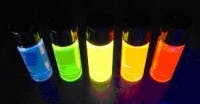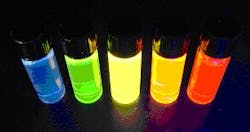Color Kinetics has been granted another patent, its 42nd, this one relating to pool and spa lighting. US patent 6,936,978 entitled "Methods and apparatus for remotely controlled illumination of liquids" was filed on October 25, 2001 and granted on August 30, 2005.
The patent describes illumination of liquids in a variety of environments. In one example, remotely controlled multi-color LED-based light sources are employed to achieve a wide range of enhanced lighting effects in liquids.
In another example, a pool or spa is illuminated by one or more remotely controlled multicolor light sources that may be employed as individually and independently controllable devices, or coupled together to form a remotely controlled networked lighting system to provide a variety of programmable and/or coordinated color illumination effects in the pool or spa environment.
Cyberlux awarded US patent claims for emergency lighting technology
Cyberlux says that the US Patent Office has allowed 22 patent claims covering Cyberlux's Emergency Lighting Augmentation System. The patent application number 20050007024 entitled "Apparatus and Methods for Providing an Emergency Lighting Augmentation System" was filed in December 2003. the patent has not yet been published.
The claims address a lighting system capable of providing long-term solutions for emergency and interim lighting. Specifically, these claims address the solid-state lighting elements and associated devices for providing emergency or temporal lighting mounted adjacent to the existing lighting system; the control circuit in electronic communication with solid-state lighting system including wireless communication; the power sensing technology for sensing power disruption in a main power supply which illuminates the lighting elements upon sensing power disruption to determining the electrical power state of an environment.
The development of Cyberlux's ReliaBright Emergency Lighting System (ELS) led to the patent filing. The ReliaBright ELS is designed to retrofit as an augmentation to existing lighting systems in commercial buildings, and it can be adapted for a variety of applications and uses. These claims lead to new opportunities for the ReliaBright ELS technology in the commercial, military and homeland security markets.
The product includes a control module powered by a constant charge battery and monitored by a sensor. The sensor differentiates between "power-off at the wall switch" and "power-out in the building's electrical service." The system's light intensity is determined by the number of solid-state lighting elements that are connected in series. Light levels range from "moonlight" to "daylight" consistent with the needs of the space in which the ReliaBright ELS is installed.
Nanosys patents cover quantum dot-enabled optoelectronic devices
Exclusively licensed from the Massachusetts Institute of Technology, the patents cover the fundamental technology to allow semiconductor quantum dots, or nanocrystals, to be used as down-converting phosphors for white and colored light emission.
In addition, these patents cover critical features of quantum dots, including fundamental new compositions of matter to significantly increase performance and capability.
The technology described in the patents is fundamental for developing quantum dots for numerous applications including: displays, lighting, and spectral encoding. Quantum dots, or nanocrystals, are known for producing extremely pure colors when electrically or optically stimulated. In contrast to traditional semiconductor materials, which are often bulk in form, quantum dots can be easily blended with polymers, gels, or implemented into porous films to produce devices such as LEDs and electronic displays.
Quantum dots offer many advantages over conventional lighting or display materials. For example, unlike traditional materials where changing color can only be achieved by using different materials, the color spectra of quantum dots made from a single material can be precisely "tuned" by just controlling their size.
The '777 and '265 patents complement Nanosys' other patents including U.S. Patent Nos. 6,322,901, 6,861,155, and 6,864,626 which cover some of the earliest work in basic core shell nanocrystals for highly efficient light emission.
The photograph shows bottles of quantum dots fluorescing from a single UV (ultra-violet) light source; all made from a non-heavy metal containing material; and displaying unique full-spectrum colors due only to their size difference. This allows Nanosys to utilize a single material system for a wide range of products from color displays for computers and televisions to LEDs for white or colored lighting applications.






